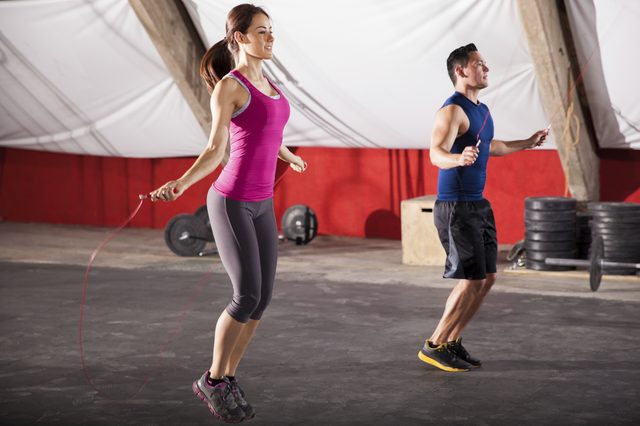It resembles a cannon-ball with a kettle-handle, a relic of the late-nineteenth-century-strongman lore when all barbells and dumbbells were black, spherical and arcane, and there were no racks, pulleys, machines or even benches. And certainly no women messing with any of this stuff -which made it all the more surreal, one Friday evening, to pass through the bright rows of the latest high-tech body machinery at a top local gym to a far corner, where a young lady swung this anachronistic piece with studied deliberation.
Pamela’s twenty-four, an IT specialist for Siemens, and she does photography on the side. Sturdily-built, serious behind small-rimmed steel glasses, she listens as her instructor, a tall young ex-Marine named Will, exhorts her: “Make it float!” She does it again, this one-arm snatch, dipping her hips as the cannon-ball arcs toward the ceiling, and swings her arm to hold it straight overhead. Another minor correction, and she does it again. And again, because she didn’t lock her arm or flex her hips to Will’s satisfaction and he’s not going to count it. Two more times and he’s pleased. “Put it down,” Will tells her. “Time for active rest!” Pamela, drenched with sweat, knows what this euphemism means, but doesn’t bat an eyelash. For the next few minutes she’ll be doing shuttle-sprints up a stair-well as Will stands above with a stop-watch. That’s one form of “active rest.” Another is “hand-to-hand,” a continuous passing of the kettlebell from hand to hand between the legs. Either way, it’s as close to a respite as she’ll get before the next drill.
According to Russian literature, the kettlebell or “girya” dates back to before 1700, and were a popular staple of physical culture in Tsarist Russia. Since then they’ve been the mainstay of conditioning for the Russian Special Forces and other military elite. According to Pavel Tsatsouline, a former physical training instructor for the Soviet Special Forces and currently an advisor to the U.S. Marine Corps and other US military and law-enforcement agencies, Soldier, Be Strong!, the official Soviet armed forces strength-training manual, declared kettlebell drills “one of the most effective means of strength development” representing “a new era in the development of human strength-potential.” Pavel, a lean, wiry guy who’s made himself something of a legend, seems to have cornered the market on this odd import.
In addition to his advisory/training positions, he’s established himself as the chief guru and purveyor of all things genuine-Russian-kettlebell through his site. His adherents, many of them physicians, military and law-enforcement guys, martial-artists and other competitive athletes, delight in documenting the superiority of kettlebells over all other training (especially bodybuilding), regaling each other with anecdotes of accomplishment and mishap. All the while, they address Pavel and each other as “Comrade.” They number in the thousands (there are kettlebell competitions (see side-bar) and even a Kettlebell Convention in Vegas). They’re hardcore, and male or female, take their toughness seriously. And some of them will even tell you they don’t want the public to discover these things.
Kettlebells come in ‘poods,’ an old Russian measure of weight, which equals 16kg, or roughly 35 lbs. According to Pavel “an average man should start with a 35-pounder. It does not sound like a lot, but believe it; it feels a lot heavier than it should! Most men will eventually progress to a 53-pounder, the standard issue size in the Russian military. Although available in most units, 70-pounders are used only by a few advanced guys and in elite competitions. 88-pounders are for mutants.”
The way kettlebells are used flouts most of the weight-training principles we’ve come to know; while bodybuilding espouses slow, controlled repetitions, focusing on one muscle-group at a time for a largely cosmetic outcome, kettlebells are to be thrust about ballistically, with the coordinated orchestration of the whole body to achieve functional strength. This is much closer to the way we exert ourselves in sport, in work, and in combat, the reasoning goes, and the ability to get tougher, rather than just bigger, is what separates the girevoy from the “girly-man.”
There’s a fundamentalism to this mock-machismo, a credo which extols the virtues of old-school functional core and tensile strength, while belittling modern trends and bodybuilding (whose only ritual Pavel would admire is that of vomiting after an intense squatting marathon). A back-to- basics recoil is inevitable in the face of today’s bewildering array of technology and gimmick-hype. And you can’t get more basic than a guy and a rock, eschewing any concessions to comfort or convenience, insisting that true results will come only with true grit. It shows in the titles of the kettlebell training books and videos: “From Russia With Tough Love.” “Power to the People!” “Stephen Maxwell’s Cruel and Unusual Kettlebell Exercises For Real Men!” It shows in Pavel’s call to “hard comrades of all persuasions” and the promise that kettlebells are “low-tech/high-concept” and will “melt fat without the dishonor of dieting or aerobics.” And it shows in the transformation of the World Gym’s Will Williams:
“My intro to Kettlebells came from Muscle Media magazine, where I read one of Pavel’s articles about the one-arm dumbbell snatch. I was deployed at sea at the time, and after my first set with a 45lb dumbbell, the rocking of the ship and a bellyful of navy chow, I made it to the head with just enough time to lose the chow and part of a lung. I knew this stuff was for me.
“KB training definitely draws stares from other gym members. They see folks of all walks swinging, snatching and throwing a little ball of iron… and they literally stop what they are doing to marvel… or run and hide. What blows most people away is how quickly they can learn these drills and benefit from them despite their initial judgment, which is born of fear. I’ve trained everyone from football players to 65 year-old grandmothers with the Bell, and have watched these people get stronger and more flexible by the moment.
“There is an air of danger to these workouts. Flying bells and cries of agony are the least of these concerns. All KB trainers know to spend at least one full workout on the most basic movement, the 2-Arm Swing, a dynamic deadlift style exercise which teaches the trainee to ‘pop his/her hips’ and make the bell FLOAT! Once it’s understood that the ‘hip-pop’ is the root of all movements, we progress accordingly to the other two initial drills, the Clean and the Snatch. The crisp popping of the hips activates the entire posterior chain of muscles and engages the hip flexors, abdominal wall, gluteus and most of all, the all-powerful hamstrings. These muscles comprise what is known as the ‘seat of power.’ No movement is satisfactory without a complete and conscious contraction of all these muscles; the ‘core’ aspect of kettlebell training stems from just that. KB drills not only support each other, but all other properly-done exercises and movements in the outside world. Posture, flexibility, strength and most noticeably, confidence, are by-products of a properly-performed KB workout.
“Some exercises may be performed with dumbbells, yet the flipping of the bell and the ballistic shock absorption necessary to complete the drill properly are what solidifies the seat of power and allows the trainee to advance. You cannot flip a dumbbell. Also the hand-to-hand drills are impossible to perform with a DB, and active rest is what helps the trainee tap into the aerobic pathway of energy production, staying mobile for anywhere from 3 to 30 minutes. When the body begins to breakdown stored fat to support the energy requirements created by these workouts, you’ve not only burned more calories but also have given yourself more energy to do more work. These sessions are absolute metabolic monsters. Last night I did a set of snatches with each arm, 25 reps with a 20-kg KB and clocked my work time at almost 4 minutes. Whoa!
“People with joint problems and spinal issues can enjoy KB drills also. The swing alone is enough to turn one’s body into a concrete network of muscles trained to work as a team, from the ground up-as it was designed. Some of the heavy overhead work is too much for people with faulty hinge joints or lumbar pain, but with proper instruction by a trainer or any of the 30-plus DVD’s and books available, many of these problems can be worked around for positive results.
“Sessions last any where from 15 to 60 minutes and you can train anywhere from two to seven times a week, with proper rest and nutrition. Most of the guys I have met who train with KB do two heavy (45) minute sessions a week and two or three ‘Man-Makers’ for cardio: a set of drills is immediately followed by 60 seconds of jumping rope and repeated. I have adopted this for the girls and dubbed it a ‘LadyKiller’ -as you saw my hardest-working client, Pam perform with relative ease.”
Speaking of Pam, she’s hooked on this stuff – even owns a kettlebell which she keeps in the car and uses wherever she gets the opportunity, such as the last time she went camping. “I’m Type-1 diabetic and do a low-carb diet,” she tells me. “I started about five months ago. Got black-and-blue forearms at first til I learned how to flip it right -everyone does. It’s part of the experience. Just like dropping the bell -it’s ten push-ups if you drop it… I did that about a dozen times in three months. But this is more fun, more intense than weights and regular cardio. I’ve lost fat and I’m stronger. Other women are curious; I get asked about it all the time.”
Will’s next client is Mary, a thirty-three year-old mother of two. She’s slightly-built compared to Pam, and she’s also newer to this, having started only a month ago after taking a “boot-camp” which Will also helps run. She says it’s increased her energy, made her stronger and helped her mentally adjust to better eating. And like most women, she doesn’t want to get bigger. The fear of “accidental” muscular hypertrophy is a common misconception about weight-training and women, but it’s a boon for kettlebells and women. Will acknowledges that most men who want added muscular size won’t get it from kettlebells. “Bodybuilders shouldn’t touch these,” he tells me, while acknowledging that he does a lot of heavy conventional free-weight work too.
I notice Will continues to use his stopwatch. Correct time under tension should be less than one and a quarter minutes, he tells me. After he helps Mary do Pistols (one-legged squats) and Tactical Lunges (the kettlebell is swung beneath the front leg) Will has her do the Swing, releasing the handle for an instant at the top of the swing to “let it float.” I ask what happens if it “floats” away. “If you lose it, let it go,” Will replies. “better that, than wreck a wrist trying to rescue it.” He adds that the proprietors of the establishment below aren’t happy about the resultant noise. So early one Saturday morning, I find Will training alone outside World Gym on the dewy grass, practicing advanced “floating” maneuvers. And once he has to “let it go,” the sphere thudding into the turf, and Will follows it, dropping for repetitions of penitence -masochistic distortion of push-ups with one foot in the air and one hand on the kettlebell (pleading forgiveness?). Then he’s on his feet again, swinging it, floating it and catching it -like so many practitioners, a man addicted. Down the sidewalk, the site of a more socially-accepted addiction, the establishment so vexed at the noise of this unholy past-time, won’t open for hours, its plate-glass windows dimly oblivious to Will and his silliness. A liquor store.




